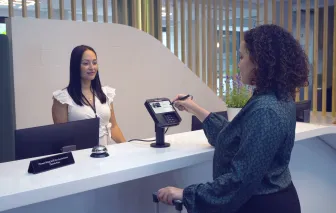The right technology can streamline processes, enhance user experiences - and save acquirers money.
When acquirers manage payment devices for their clients, they incur expenses. But they also know time is money. Traditional device provisioning, implementation, and lifecycle management processes are typically high-touch, requiring careful tracking and quick turnaround when a merchant needs terminal maintenance, repair, or replacement.
However, payment technology platforms designed for flexibility and remote capabilities can reduce those costs while also optimizing user experiences for merchants.
3 Ways Acquirers Can Control Costs
Acquirers should evaluate the technology they use and the processes they have established against the efficiency and cost-savings of using modern payment technology.
- Single-source integration
Integration with payment devices is a labor-intensive—and costly—process. Consider working with a partner that offers a platform that requires just a single integration to give you access to device management, dynamic currency conversion (DCC), buy now, pay later (BNPL) apps at the point of sale, other alternative payment methods, and more. Additionally, single-source integration enables an ecosystem that allows you to white-label the payment solutions and services you provide to your customers.
- Remote key injection
Acquirers using traditional processes to provide payment terminals to their clients use manual key injection. The technology is essential, facilitating encryption at the point of sale. But the process is labor-intensive and time-consuming, and errors create serious compliance and security issues. With manual key injection, the payment device goes from the manufacturer or distributor to a Payment Card Industry (PCI)-compliant key injection facility. It takes time and labor to track terminals and ensure the correct devices are shipped to the right locations.
Remote key injection saves time by enabling manufacturers or distributors to send devices directly to the merchant. Then, once the merchant connects them to their system, they receive their key remotely within a few minutes. There are no concerns about lost devices, shipping errors, or the labor required to manage devices by account. Furthermore, if an acquirer closes a deal with a merchant that previously worked with another company, remote key injection eliminates downtime and enables the merchant to begin accepting payments through the new company more quickly.
- Remote monitoring and maintenance
At some point, every payment terminal will require updates, maintenance, or repairs. Managing a large number of devices across numerous merchant locations requires calls with customer support, depot service, and, sometimes, onsite technician calls. It’s necessary, inevitable, and typically chalked up to the cost of doing business.
However, with remote capabilities, acquirers can monitor device deployments to check device performance and functionality and proactively schedule inspections to look for issues. This allows the acquirer to address problems before they result in downtime and emergency repairs. Moreover, acquirers can manage some issues remotely, eliminating the need to ship the device or have a tech go to the site.
In other cases, merchants will bring issues to the acquirer’s attention. A terminal that enables the merchant to open a ticket right from the device and give a technician screen-sharing capabilities will save time and resolve issues to the merchant’s greater satisfaction—and more cost-effectively.
Every Second and Every Penny Count
Reducing the time and effort of managing payment devices through manual key injection processes, shipping, and onsite repair costs will make a positive impact on the bottom line. For example, CompTIA research shows that half of companies that use managed services can reduce costs by up to 25%, and about one-third save up to 50%.
To learn more about payment devices designed to provide all of the payment functionality merchants need and efficiency and cost-savings for acquirers, contact us.











